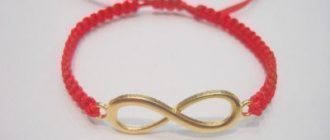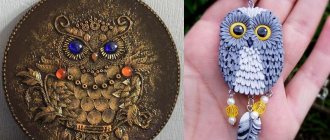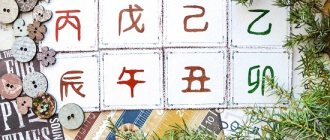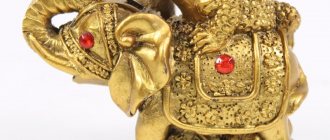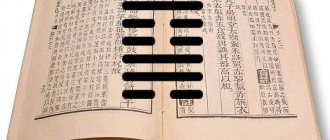In Sanskrit, the infinity knot is called “srivatsa”, which means “beloved Sri Lakshmi” - the wife of the god Vishnu. According to legend, Vishnu has a curl of hair growing on his chest in the shape of an infinity knot.
An alternative name for the curl of chest hair is “nandyavarta”, or “curl of happiness”, it is drawn as a swastika symbol or a Greek cross of hooks (Greek gammadion)1.
The Buddhist infinity knot is one of the Eight Noble Symbols of Buddhism - Ashtamangala:
- a good umbrella symbolizes the nobility of origin and protects against defilements;
- two golden fish symbolize the end of suffering, spiritual liberation;
- a precious vase is a symbol of the realization of all desires, both worldly and spiritual;
- lotus means non-attachment to samsara, but presence in it untainted;
- a white shell with a curl to the right means the sounds of the Buddha's words spreading around and awakening living beings from ignorance;
- the endless knot means the complete acquisition of the Immeasurable Virtues and the Five Kinds of Primordial Wisdom;
- the banner of victory is a symbol of the victory of the Buddha’s Teachings over ignorance, old age, illness and death;
- wheel of dharma: turning the wheel means preaching the Teachings of the Buddha, which frees living beings from obscurations.
General information about the Tibetan infinity knot
The Tibetan infinity knot is the personification of samsara.
In the intertwining of the Tibetan knot it is impossible to find the beginning and the end, which reminds us of the boundlessness of the Universe and the inexhaustibility of life. Therefore, all interpretations of this sign come down to manifestations of infinity.
What does it look like
The Tibetan endless knot is depicted as a closed symmetrical pattern, built from successively intertwined lines bending at right angles.
In the classic version, it has 9 intersection points, but theoretically it can have any number of repeating elements. In various artistic forms, the eternity knot is found in Mongolian, Chinese, Indian and Celtic traditional symbolism.
An endless knot without beginning or end.
Meaning and symbolism
The ornament, which has no beginning or end, symbolizes the continuity of the existence of the surrounding world. The interweaving of lines indicates that all natural phenomena are connected in a single closed cause-and-effect cycle. The infinity knot should be perceived as a figurative form of absolute harmony and simplicity of being.
In traditional Buddhism, the ornament symbolizes the inexhaustible wisdom and compassion of the Buddha - a state of spiritual perfection.
It is included in Ashtamangala - a set of 8 auspicious symbols depicted on ritual objects. Each of these signs personifies one of the aspects
The noble eightfold path, leading a person to liberation from suffering and the need for rebirth. The endless knot means the right effort, expressed in the desire for maximum concentration of internal energy and tranquility.
Ashtamangala - set of 8 Buddhist infinity symbols.
When are knots used and what do they mean?
The knots themselves contain an interesting, but at the same time simple, subtext. In Buddhism, tying a knot and untying it even becomes a certain ritual.
It is believed that by tying it, we launch the flywheel of karma and enclose energy in this knot. If the energy is positive, then it will lead to favorable consequences and contain a good wish. When tying, we seem to acquire, capture something.
When tying a knot with your own hands, you can read mantras - this will enhance the effect and become an excellent amulet.
The node preserves the idea, the plan. The opposite action occurs when untying - we release energy, get rid of unnecessary things, let go of the past.
Knots are often tied on rosaries. 108 beads are strung on a thread or string. Above them there should be the main, 109th bead, which symbolizes the head of Buddha. Then you need to make the knot correctly so that the beads close together.
Perhaps most often in Buddhism, knots are found in the list of eight noble symbols of the dharma:
- umbrella;
- vase;
- sink;
- goldfish;
- victory banner;
- lotus bud;
- eight-spoke wheel;
- infinity knot.
History of the origin of the symbol
The history of the eternity symbol goes back more than 4 thousand years. Its earliest depiction is found on clay tablets found in the Indus Valley and dating back to 2500 BC. e.
It is believed that the prototype of the endless knot is the ouroboros - a snake curled into a ring and biting its own tail. The exact age of this symbol is unknown, but already in the 14th century. BC e. it was present among the main motifs of ancient Egyptian iconography.
Over time, it was borrowed by Western and later Eastern philosophers. The symbol of ouroboros penetrated into India and Tibet in the 1st millennium BC. e., having been developed within the concepts of kundalini and samsara. Over time, it was transformed into the image of an endless knot.
Followers of Buddhism believe that the symbol of eternity was presented by the gods to the founder of the religious teaching, Siddhartha Gautama Shakyamuni, as a reward for achieving enlightenment.
Longevity knot meaning
One of the most common and complex is the longevity or infinity knot. It is tied in such a way that it is impossible to find where one end begins and the other ends. The complexity of the weave is explained by its meaning. The Tibetan knot, as it is otherwise called, is one of the eight symbols of Tibetan Buddhists. It opens the way to knowledge of the great secret of immortality, as well as unfading youth and beauty. The continuity of the line, its infinity, encourages a person to be patient and remain consistent in achieving his goals, and the complexity of tying it speaks of the complexity of the path of knowledge.
In the Vajrayana system - the yogic occult practice of Buddhist traditions, the interpretation of this symbol is more complex and profound. In this system, the Infinity Knot personifies universal justice and is considered a symbol of fate entangling everything earthly with its threads. Its complex interweavings stretching into infinity express the main karmic law - everything has consequences. Thoughts, actions, deeds done by a person will certainly affect him over time. Every time, unraveling a problem or difficulty in one place, our fate, according to the karmic laws of the Universe, ties it up in another place.
In Buddhist philosophy, the knot determines the inseparability of the concepts of compassion and wisdom - the main qualities of life that help to cope with internal contradictions and imperfections of the world. This symbol has become part of meditation, helping to understand oneself and the Universe around.
Magical powers
The infinity symbol is widely used in knot magic - the mystical practice of weaving artifacts that can influence the course of events. Nauzs made in a special way were used as amulets to protect against damage.
They resorted to their help in order to gain longevity, attract family happiness, and achieve commercial success. However, sciences were often used to interfere with enemies.
Weaving the Tibetan knot is identified with attracting and maintaining positive energy in one’s life, embodied in the form of inspiration and wealth. On the contrary, its unleashing is accompanied by various losses.
What brings
The amulet gives its owner many opportunities, qualities, and protects against failure. Thanks to him, a person can learn to set the right goals, move towards them and achieve them. Moreover, he is able to attract good luck.
It is believed that the knot also helps to manage time correctly and avoid wrong actions and rash actions. To achieve an even greater effect, some people combine knots with other lucky symbols.
The only thing you need to remember is that the knots of eternity are closely related to the laws of karma. If the wearer of the amulet commits bad actions, the nodes will immediately return the corresponding consequences to him and restore justice.
And, of course, the most important thing to do for the knot to work as a talisman is to sincerely believe in its power and bright future.
The nuances of making it yourself
Although you can buy a talisman in a store, it is recommended to make it yourself to increase effectiveness. The knot should not be considered as decoration and expensive materials should not be used.
Detailed weaving pattern
There are many options for weaving the eternity symbol. You can tie simple, complex, double knots.
The scheme for creating the classic version looks like this:
- Take a thread 3 m long, find the middle and pin it to the pillow with a pin. Each half is bent so that a loop is formed.
- The right end is pulled from right to left through vertical segments, following the algorithm. Moving in the opposite direction, the actions are repeated. A second similar loop is formed with the same end.
- The other end is pulled from left to right over the vertical segments. Before reaching the extreme bend, unwind the thread and lead it from right to left under the loops. A second similar element is formed below.
- Without letting go of the left end, form a vertical loop. Moving from bottom to top, follow the pattern “under 1 – over 3 – under 1 – over 3”, and in the opposite direction – “under 2 – over 1 – under 3 – over 1 – under 1”.
- The knot is compacted and aligned by carefully pulling the loose ends and eye loops.
Where and how to place the Mystic Node
First, decide what you want, what goals, desires, dreams you want to fulfill first. If you don’t yet know what you want, then you can hang the Mystic Knot anywhere, the talisman will simply harmonize the space. Well, if you know what you want, then hang talismans depending on your desires. And additions to the mystical knot can be made of different materials, for example: metal or stone, plastic or glass. If your desire is money, wealth, increasing your standard of living, then the sector: Wealth, Helpers, Glory, Career and Wisdom. But here are the elements in addition to the Mystical Knot that these sectors should have: a Chinese coin or 9 coins, figures of a Money Toad, Hottei, a gold bar, hieroglyphs of “Glory”, “Money”, “Wealth”, “Abundance”, etc. Yours the desire to succeed at work, in business, creativity, or you want to become famous, hang the Mystic Knot in these sectors of Career, Fame, Assistants and of course Wealth. Additions to the mystical knot: figures of a galloping horse (preferably upward), Hottei, Ganesha, Dragon or Phoenix, 9 or 8 Chinese coins connected to each other, hieroglyphs “Career”, “Glory”, “Prosperity”, “Business”. If your desire is: to find your love, start a family, have children, improve your health, the sectors you need are “Love and Marriage”, “Family”, “Children”, Helpers” and “Health”. Additions to the mystical knot in these sectors: figurines of a pair of mandarin ducks, hearts, a pair of doves or cranes, a phoenix bird or the goddess Lakshmi. And naturally, when you stir your beneficial Mystic Knot, be sure to think about your desire or dream. But the main thing is to awaken your creativity, be bolder, fantasize and perhaps make a wonderful talisman of good luck, happiness, abundance with your own hands, but more on that a little later.
How to use it correctly
Today, the infinity knot is more often used as an amulet that must be worn on the body. It can be made from wire, rope, tape and even painted on clothing. If the sign is depicted on home decor items, then good luck will accompany all family members.
Activation
In order for the Tibetan mystical symbol to gain energy and serve as a strong amulet, it is necessary to invest the energy of your desire into it during weaving.
You should concentrate on one thought and imagine how it penetrates the knot.
It is also recommended to listen to Tibetan mantras, which will help set your mind to the right rhythm and transfer it to the talisman.
What does it symbolize
The infinity knot is a very ambiguous symbol that hides many meanings. There are several interpretations of its meaning:
- eternity;
- an ongoing cycle of rebirth;
- knowledge of the immortal essence, long youth;
- the profound wisdom of the Buddha;
- interdependence, impermanence of things and events in the Universe;
- the mutual connection of mercy and wisdom;
- variability of the passage of time;
- getting rid of ignorance;
- endless possibilities of the mind;
- absolute beauty, joy, love.
Vajrayana views knots as representing the consequences of karma.
Infinite Luck Knot. Magic knots Feng Shui
Application of the Chinese knot in clothing
According to the teachings of Feng Shui, everything in the world is determined by the harmony of 5 elements: Fire, Water, Wood, Metal and Earth. Their interaction gives rise to a certain influence of Qi energy on people, objects and events. And knots are perfect for attracting this positive energy.
On the one hand, the nodes are harmonious, do not have sharp corners, and do not have an aggressive nature. On the other hand, they are distinguished by their individuality, which makes them universal for every sector. You can use any rope for knitting. The main thing is that it is original and beautiful in texture. If you take a tow that is not combed or twisted, you can get the most interesting knots.
There is a mystical knot in Feng Shui that increases luck, health, wealth, success in relationships and various areas of life. Symbolizes longevity, resistance to disease, guarantees a strong marriage. Can protect against hostility, prevent financial losses. It is an endless cycle in which there is neither beginning nor end. You can carry it with you on your clothes. We’ll talk in more detail about the mystical knot, its application and the method of knitting a little further, but for now let’s return to knots in the general sense of the word.
Knots that are tied from hand-twisted rope look great. Sesal (palm fibers) is perfect for this. The result is a very interesting weaving structure, uneven, not smoothed, like an ancient flow of Qi, and, as you know, like tends to like.
The uniqueness of the knots used in Feng Shui is a prerequisite. They should vary in size, density, method of knitting or even weaving. Interestingly, it is almost impossible to “tie” a real knot in Feng Shui. We have to resort to various weaving techniques. As the knot is made, you can apply decorations, but without frills. Otherwise, a situation will arise when simplicity is replaced by sophistication, and this is wrong from the point of view of Feng Shui.
Each node is created with a specific intent. When weaving, it is necessary to clearly formulate what it is weaving for, and keep this thought throughout the entire work. After this, it can be placed in a specific sector corresponding to the target. If our intention was related to a career, we use the sector of the same name. Wealth to wealth, family to family and so on.
In addition, you can knit knots to wear on clothes as amulets, amulets of good luck and for other purposes. You can even disguise it by placing such a knot between other simple ties on your clothing, bag, shoes or backpack. Easily transform it into a piece of jewelry such as a pendant, necklace, or bracelet on your arms or legs. Originality is very important, it attracts prying eyes, and this leads to the activation of the amulet, which makes its effect more pronounced. You can use a double knot in Feng Shui, a ball, a Mystical knot, etc., which looks especially good on clothes. There are a lot of options. Let's figure out exactly how knots are woven. And let's do this using the mystical example.
Effect on humans
With the help of such a talisman, a person can change his life for the better, understand himself, learn to analyze his actions, so he can realize what exactly he is missing in life and how to achieve it. With the help of an amulet you can find the right path and make the most correct decision.
With the help of a talisman, a person can learn to analyze his actions
When choosing such a talisman, you should take into account that it will constantly encourage you to act and seek the truth. A person will be able to discover new abilities in himself and will strive for self-realization. Also, the longevity knot represents harmonious relationships in a married couple.
Who needs to wear a talisman
In order for the amulet to begin to work, a person must believe in its mystical power. Before you start using the amulet, you must first cleanse yourself of negativity, resentment, and evil thoughts. It is important to carry the amulet with you at all times, this is the only way it will work. Your well-being will improve, inner freedom, joy, and a desire for change will appear.
With the help of such a magical knot, you can find happiness in your personal life and find a compromise with your loved one. This amulet is suitable for people who get sick often, who have chronic diseases that are difficult to cure. This is a very strong energy amulet. Before you start using it, you need to decide for what purpose it will be intended.
There is also a certain category of people who are not recommended to wear a knot:
Pregnant women are prohibited from wearing such a talisman
- Pregnant women should not wear such a talisman; it is believed that it can negatively affect the process of the birth of a child.
- It is also not recommended to wear a talisman for those people who have just gotten married, since their union is not yet so strong, it is only gaining wisdom and life experience.
- People who are actively developing their own business should not use such an amulet. Such a node will interfere with the conclusion of transactions or negotiations.
This knot is made of cords and threads. You can also make a smaller copy and wear it as a pendant.
See also[edit]
- Ashtamangala (also known as eight auspicious symbols)
- Celtic knot
- Chinese knitting
- Eternal Return
- Gordian knot
- Indra's Network
- Islamic interlaced patterns
- Khachkars - Armenian embroidery
- Garden knot
- Knot theory
- Mandala
- the Mobius strip
- Namka
- Oseberg style
- Ouroboros
- Solomon's knot
- Tantra
- Three rabbits
- Trefoil knot
- Triquetra
- Turk's head knot
- Valknut
- Yin and Yang

